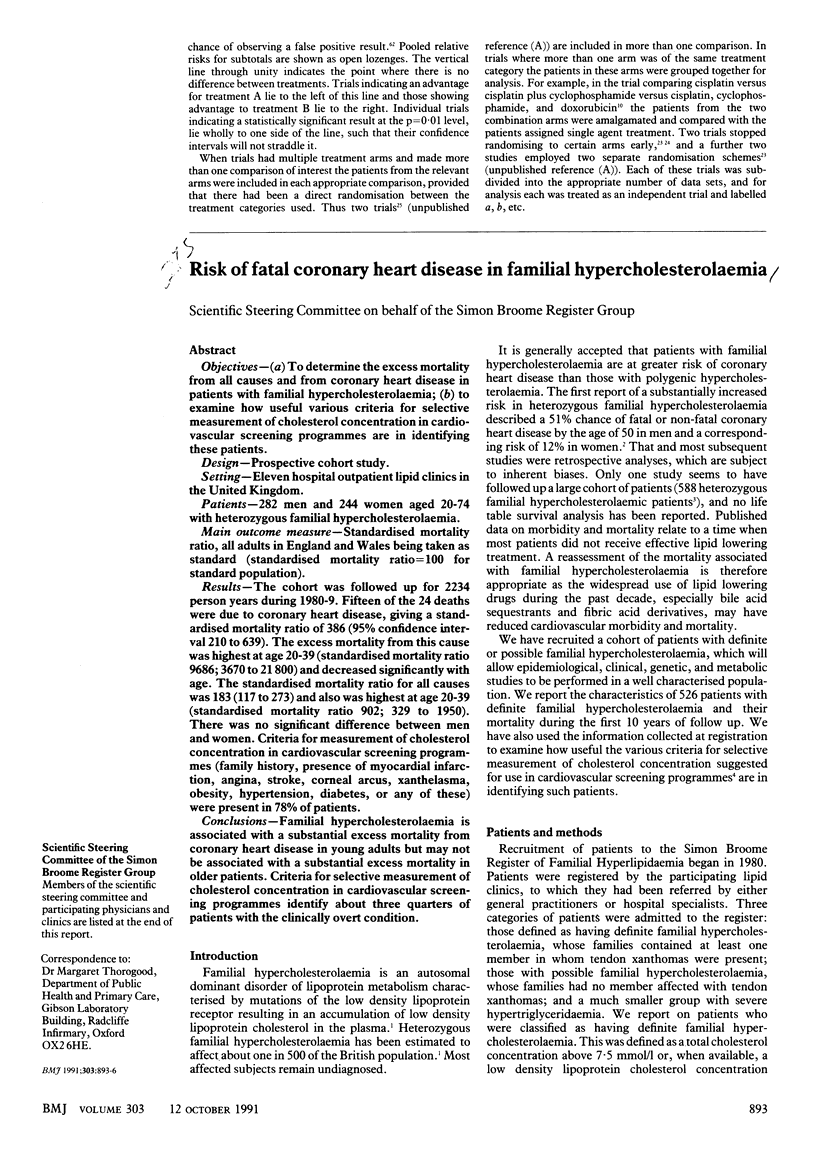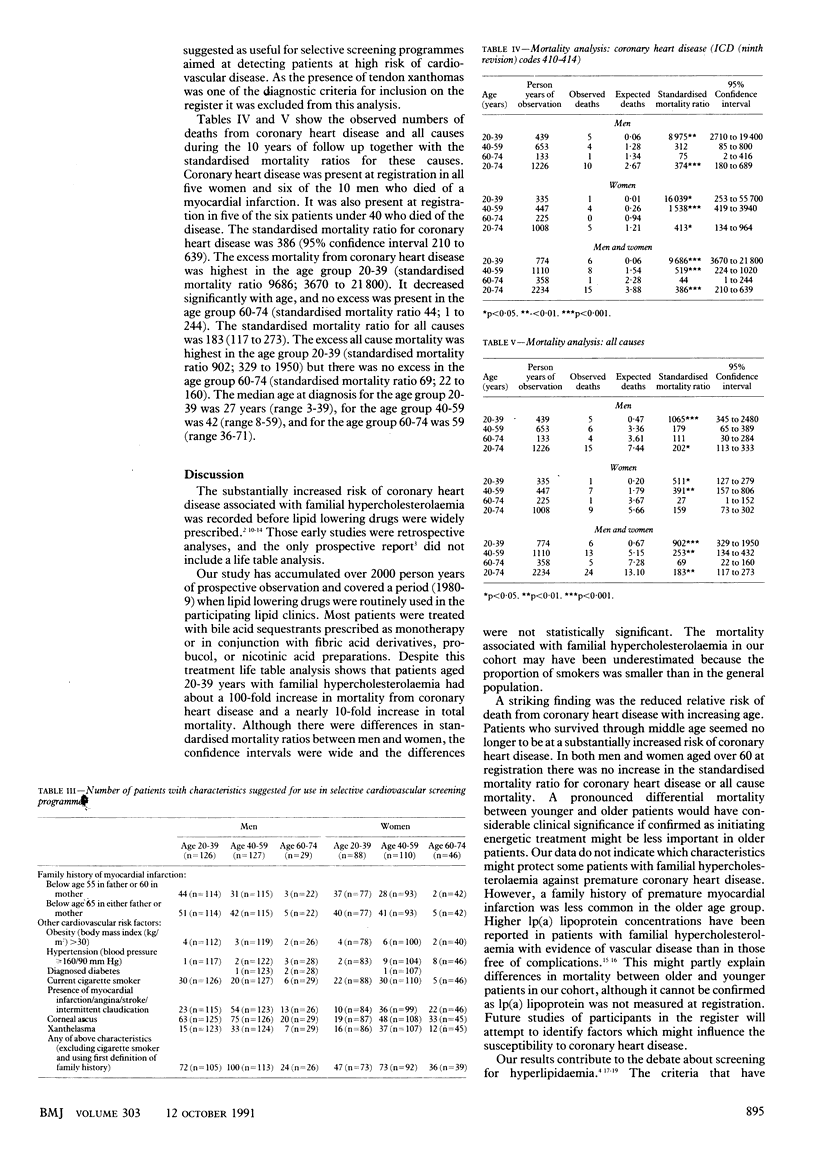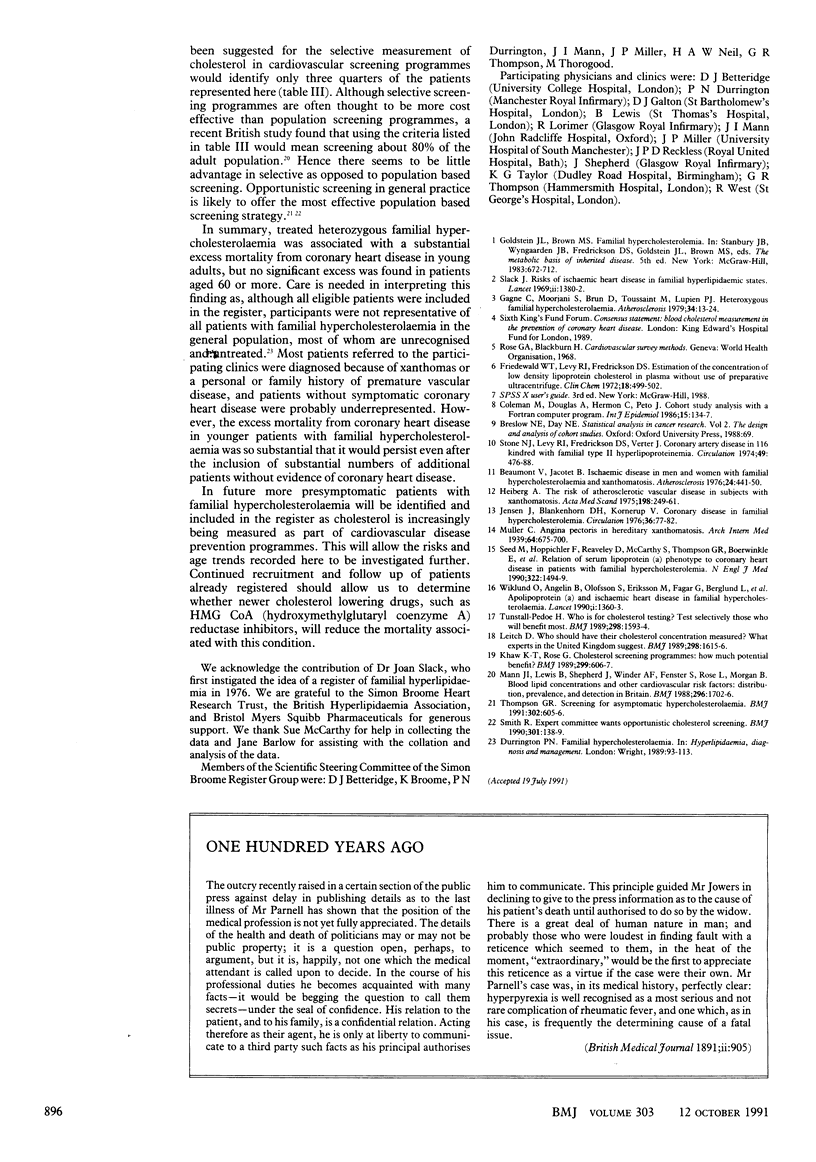Abstract
OBJECTIVES--(a) To determine the excess mortality from all causes and from coronary heart disease in patients with familial hypercholesterolaemia; (b) to examine how useful various criteria for selective measurement of cholesterol concentration in cardiovascular screening programmes are in identifying these patients. DESIGN--Prospective cohort study. SETTING--Eleven hospital outpatient lipid clinics in the United Kingdom. PATIENTS--282 men and 244 women aged 20-74 with heterozygous familial hypercholesterolaemia. MAIN OUTCOME MEASURE--Standardised mortality ratio, all adults in England and Wales being taken as standard (standardised mortality ratio = 100 for standard population). RESULTS--The cohort was followed up for 2234 person years during 1980-9. Fifteen of the 24 deaths were due to coronary heart disease, giving a standardised mortality ratio of 386 (95% confidence interval 210 to 639). The excess mortality from this cause was highest at age 20-39 (standardised mortality ratio 9686; 3670 to 21,800) and decreased significantly with age. The standardised mortality ratio for all causes was 183 (117 to 273) and also was highest at age 20-39 (standardised mortality ratio 902; 329 to 1950). There was no significant difference between men and women. Criteria for measurement of cholesterol concentration in cardiovascular screening programmes (family history, presence of myocardial infarction, angina, stroke, corneal arcus, xanthelasma, obesity, hypertension, diabetes, or any of these) were present in 78% of patients. CONCLUSIONS--Familial hypercholesterolaemia is associated with a substantial excess mortality from coronary heart disease in young adults but may not be associated with a substantial excess mortality in older patients. Criteria for selective measurement of cholesterol concentration in cardiovascular screening programmes identify about three quarters of patients with the clinically overt condition.
Full text
PDF



Selected References
These references are in PubMed. This may not be the complete list of references from this article.
- AIDS and 'ordinary heterosexual people'. BMJ. 1990 Jul 21;301(6744):138–138. [PMC free article] [PubMed] [Google Scholar]
- Beaumont V., Jacotot B., Beaumont J. L. Ischaemic disease in men and women with familial hypercholesterolaemia and xanthomatosis. A comparative study of genetic and environmental factors in 274 heterozygous cases. Atherosclerosis. 1976 Sep;24(3):441–450. doi: 10.1016/0021-9150(76)90136-2. [DOI] [PubMed] [Google Scholar]
- Coleman M., Douglas A., Hermon C., Peto J. Cohort study analysis with a FORTRAN computer program. Int J Epidemiol. 1986 Mar;15(1):134–137. doi: 10.1093/ije/15.1.134. [DOI] [PubMed] [Google Scholar]
- Friedewald W. T., Levy R. I., Fredrickson D. S. Estimation of the concentration of low-density lipoprotein cholesterol in plasma, without use of the preparative ultracentrifuge. Clin Chem. 1972 Jun;18(6):499–502. [PubMed] [Google Scholar]
- Gagné C., Moorjani S., Brun D., Toussaint M., Lupien P. J. Heterozygous familial hypercholesterolemia. Relationship between plasma lipids, lipoproteins, clinical manifestations and ischaemic heart disease in men and women. Atherosclerosis. 1979 Sep;34(1):13–24. doi: 10.1016/0021-9150(79)90101-1. [DOI] [PubMed] [Google Scholar]
- Heiberg A. The risk of atherosclerotic vascular disease in subjects with xanthomatosis. Acta Med Scand. 1975 Oct;198(4):249–261. doi: 10.1111/j.0954-6820.1975.tb19536.x. [DOI] [PubMed] [Google Scholar]
- Jensen J., Blankenhorn D. H., Kornerup V. Coronary disease in familial hypercholesterolemia. Circulation. 1967 Jul;36(1):77–82. doi: 10.1161/01.cir.36.1.77. [DOI] [PubMed] [Google Scholar]
- Khaw K. T., Rose G. Cholesterol screening programmes: how much potential benefit? BMJ. 1989 Sep 2;299(6699):606–607. doi: 10.1136/bmj.299.6699.606. [DOI] [PMC free article] [PubMed] [Google Scholar]
- Leitch D. Who should have their cholesterol concentration measured? What experts in the United Kingdom suggest. BMJ. 1989 Jun 17;298(6688):1615–1616. doi: 10.1136/bmj.298.6688.1615. [DOI] [PMC free article] [PubMed] [Google Scholar]
- Mann J. I., Lewis B., Shepherd J., Winder A. F., Fenster S., Rose L., Morgan B. Blood lipid concentrations and other cardiovascular risk factors: distribution, prevalence, and detection in Britain. Br Med J (Clin Res Ed) 1988 Jun 18;296(6638):1702–1706. doi: 10.1136/bmj.296.6638.1702. [DOI] [PMC free article] [PubMed] [Google Scholar]
- Seed M., Hoppichler F., Reaveley D., McCarthy S., Thompson G. R., Boerwinkle E., Utermann G. Relation of serum lipoprotein(a) concentration and apolipoprotein(a) phenotype to coronary heart disease in patients with familial hypercholesterolemia. N Engl J Med. 1990 May 24;322(21):1494–1499. doi: 10.1056/NEJM199005243222104. [DOI] [PubMed] [Google Scholar]
- Slack J. Risks of ischaemic heart-disease in familial hyperlipoproteinaemic states. Lancet. 1969 Dec 27;2(7635):1380–1382. doi: 10.1016/s0140-6736(69)90930-1. [DOI] [PubMed] [Google Scholar]
- Stone N. J., Levy R. I., Fredrickson D. S., Verter J. Coronary artery disease in 116 kindred with familial type II hyperlipoproteinemia. Circulation. 1974 Mar;49(3):476–488. doi: 10.1161/01.cir.49.3.476. [DOI] [PubMed] [Google Scholar]
- Thompson G. R. What should be done about asymptomatic hypercholesterolaemia? BMJ. 1991 Mar 16;302(6777):605–606. doi: 10.1136/bmj.302.6777.605. [DOI] [PMC free article] [PubMed] [Google Scholar]
- Tunstall-Pedoe H. Who is for cholesterol testing? Test selectively those who will benefit most. BMJ. 1989 Jun 17;298(6688):1593–1594. doi: 10.1136/bmj.298.6688.1593. [DOI] [PMC free article] [PubMed] [Google Scholar]
- Wiklund O., Angelin B., Olofsson S. O., Eriksson M., Fager G., Berglund L., Bondjers G. Apolipoprotein(a) and ischaemic heart disease in familial hypercholesterolaemia. Lancet. 1990 Jun 9;335(8702):1360–1363. doi: 10.1016/0140-6736(90)91242-3. [DOI] [PubMed] [Google Scholar]


